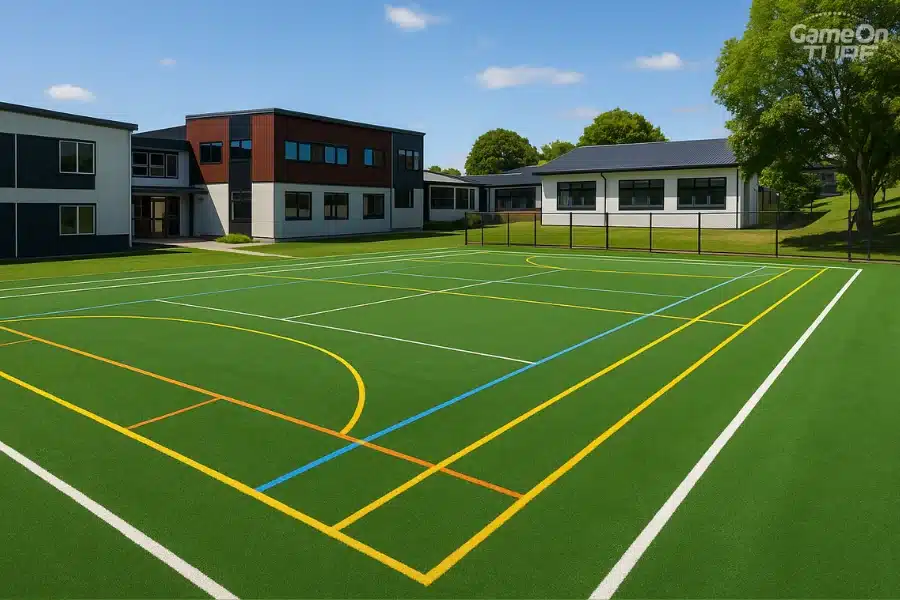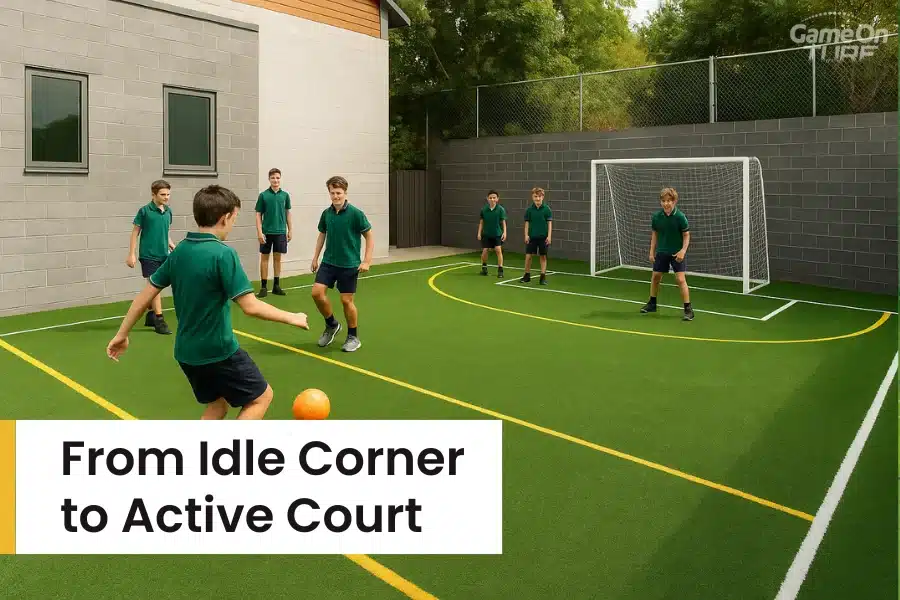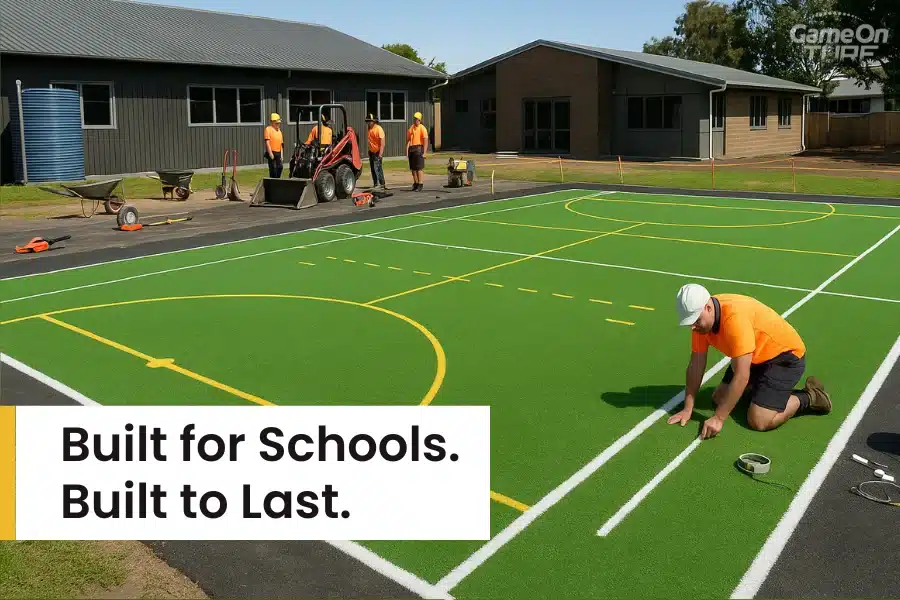

Schools are under pressure to offer more sporting options, but with limited space and budgets, building a separate court for every sport isn’t realistic. School leaders must also ensure every part of the grounds gets year-round use.
This is where multi-sport artificial turf courts prove their value.
A multi-sport turf court is a single, durable surface designed for different sports including football, tennis, hockey, futsal, netball, and more. It’s built and marked so schools can easily transition between activities without needing separate setups.
This allows schools to create an all-in-one sports solution using existing space, supporting a wide range of activities and helping more students get involved in physical activity.
As interest in sports grows and resources remain tight, schools see artificial turf multi-sport courts as a smart investment that delivers long-term value, promotes student wellbeing, and avoids unnecessary land expansion.
In this article, we’ll explore why early planning and partnering with experienced turf specialists is the most reliable path to creating safe, efficient, and student-friendly multi-sport courts.

One of the biggest challenges schools face today is managing limited space while trying to offer students more opportunities for physical activity. The idea of building separate facilities for every sport is no longer practical for most schools. That’s where multi-sport artificial turf courts offer a smart and effective solution. By supporting a wide range of sports on a single surface, these courts help schools use their grounds more efficiently without the need for additional land or costly infrastructure.
The size of a multi-sport court can vary depending on the available space, the sports it’s intended to support, and the age group of users. However, there are general guidelines schools and turf specialists follow when planning one.
Here are the common size ranges used for school-based multi-sport courts:
| Court Type | Typical Dimensions (Length × Width) |
| Primary School (compact) | 22–28 metres × 12–15 metres |
| Secondary School (standard) | 30–36 metres × 16–20 metres |
| Full-sized multi-sport | 40 metres × 20 metres |
Artificial turf surfaces are designed to handle several sports on the same court. This gives schools flexibility and allows them to support a wider variety of activities during the day.
Sports that can be played on one turf court include:
Each sport can be played without needing different equipment or layouts. Professional line markings in different colours help distinguish boundaries, reducing confusion during class or training. These markings are:
This efficient layout saves time and helps staff run sessions with less preparation and setup.
Many schools have open or uneven spaces that sit idle for most of the year. Artificial turf makes it possible to turn these areas into reliable and engaging sports zones without major site redevelopment. Common areas that can be upgraded include:
Because turf surfaces are durable and all-weather, schools don’t need to worry about damage or delays from wet conditions. They also don’t require recovery time like natural grass, which often becomes unusable during winter months or after extended use.
A well-installed artificial turf court offers consistent playing conditions across all seasons. This gives schools the advantage of scheduling sports and PE lessons without being affected by weather.
Benefits include:
The surface also provides a softer, more even playing field, which helps reduce the risk of injury and encourages more students to get involved in sports regularly.
Multi-sport turf courts allow schools to do more with the space they already have, without overextending their budgets. When planned with the help of experienced turf specialists, these courts can serve a wide range of needs while remaining easy to maintain over time.
In summary, artificial turf courts offer:
It’s a smart step forward for schools wanting to support student wellbeing, increase participation, and make full use of their grounds.
Schools often face the challenge of limited outdoor space, yet students expect access to a variety of sports. Building individual courts for each activity isn’t always possible, especially when land and budgets are restricted. That’s where multi-sport turf courts offer a clear advantage. These courts are designed to support a range of sports on a single surface, helping schools get more from their existing grounds.
With the right surface and professional markings, a single artificial turf court can be used for several types of sports. This means one space can easily support multiple programmes throughout the school day.
Students and teachers can rotate between sports without needing major setup changes, saving time and reducing the need for multiple facilities.
The design of multi-sport turf courts includes multi-coloured, clearly defined line markings. These are professionally installed to prevent overlap and keep each sport’s layout distinct.
Benefits of this structured layout include:
This clarity is especially helpful in school settings where a mix of age groups and skill levels are using the court throughout the day.

Schools often have corners of land or patches of grass that aren’t fully utilised. Artificial turf makes it possible to turn those underused areas into functional, high-use sports spaces.
Common spaces that can be converted include:
Because turf courts are all-weather and low maintenance, they can be used consistently year-round. This transforms previously idle land into active areas where students can stay engaged and physically active.
For schools working with limited budgets, making smart decisions about where and how to invest in facilities is essential. Multi-sport courts made with artificial turf present a practical solution that helps schools meet their sporting needs without overspending. These courts reduce upfront costs and lower ongoing expenses, offering real long-term value.
Installing one well-designed artificial turf court that supports multiple sports is significantly more affordable than building several individual courts. Each separate surface requires its own groundwork, base preparation, and construction process, which quickly adds up in both time and money.
With a single multi-use turf surface, schools benefit from:
This makes the project more achievable and allows funds to be directed toward other key school priorities.
Multi-sport turf courts are built for flexibility. One space can be equipped to handle a variety of games, allowing the same set of infrastructure to support several uses. This reduces the need for duplicate equipment and materials.
Examples of shared features include:
By using one setup for many sports, schools avoid the extra costs of maintaining several separate courts and associated equipment.
Unlike natural grass, which requires mowing, irrigation, and frequent repair, or hard courts that are prone to cracks and surface wear, artificial turf is designed to last. It stays usable in different weather conditions and doesn’t suffer from the same seasonal wear-and-tear issues.
Schools benefit from:
With lower maintenance costs over time, schools save both time and money. They also avoid unexpected repair expenses, helping to keep financial planning straightforward and reliable.
Encouraging students to stay active is a key goal for every school, but maintaining consistent participation in sport can be difficult when outdoor spaces are limited, weather-dependent, or unsuitable for all age groups. Artificial turf helps solve this challenge by providing a safe, versatile surface that supports a broad range of activities. When designed with schools in mind, turf courts create a welcoming environment that motivates more students to get involved—no matter the season or their skill level.
Multi-sport artificial turf courts are designed to accommodate different sports and physical education programmes on a single surface. Whether it’s football during PE, futsal after school, or netball during break times, turf allows students to move easily between activities without delay or setup complications.
Schools benefit from:
This flexibility means students are more likely to take part regularly, helping schools meet activity targets and support diverse sporting interests.
Artificial turf provides a cushioned, non-slip surface that is softer underfoot compared to concrete or asphalt. This makes it safer for students to run, fall, and play—especially in high-activity games. It also helps reduce common playground injuries like grazes, twisted ankles, and impact-related bruises.
Turf surfaces also support inclusivity by being accessible to students with a range of physical needs. Smooth, even ground allows those with mobility challenges or disabilities to join in safely and comfortably.
Key benefits include:
This inclusive design helps all students feel confident and capable during sports sessions, encouraging wider participation.
Physical activity plays a vital role in improving not just student health, but also their focus, confidence, and classroom engagement. Having access to a clean, weather-ready turf surface makes it easier for schools to keep students active on a regular basis.
When students enjoy their sports environment, they’re more likely to get involved and stay involved. This leads to:
By making sport more accessible, enjoyable, and consistent, artificial turf helps create a school culture that values physical health, inclusivity, and active learning.
When schools decide to invest in a multi-sport turf court, the choice of supplier is just as important as the surface itself. Working with a team that understands the specific needs of schools ensures the project runs smoothly, meets compliance requirements, and delivers long-lasting value. Turf suppliers with proven experience in education environments bring practical insight, reliable products, and solutions that support both safety and long-term use.
Not all turf installations are the same. Schools require a different level of planning and care compared to sports clubs or private venues. An experienced turf supplier who has worked with educational facilities understands the pressures of busy school schedules, the need for safety, and the importance of long-term durability.
Specialist suppliers offer:
High-quality, non-toxic turf materials
Surfaces are chosen for their safety, performance, and compliance with national standards. These materials are child-safe and tested for durability under constant use.
Weather-resistant finishes
Turf used in school settings must perform consistently in all seasons. Experienced suppliers select turf systems that drain quickly, dry faster, and stay usable during wet months, ensuring fewer cancelled sessions and more reliable access.
Layout and drainage planning tailored to school needs
Experts help design the court with your school’s daily use in mind. This includes identifying the best layout for student flow, planning adequate drainage to prevent water build-up, and suggesting maintenance schedules that suit term calendars.
Turf courts in schools are exposed to heavy foot traffic, varied age groups, and daily wear. A supplier experienced in educational projects takes these demands into account from the start, helping schools avoid problems later.
What schools gain from expert suppliers includes:
This level of detail ensures the court is safe, functional, and able to withstand years of school activity.
Installing a multi-sport artificial turf court is a significant project, but it doesn’t need to interfere with the school day.
When schools work with experienced and reliable turf suppliers, the entire process—from initial planning to final delivery—can be managed with minimal disruption to students, staff, and regular operations. Skilled teams know how to work efficiently within the unique constraints of a school environment, ensuring the court is completed on time, within budget, and with careful consideration for safety and daily routines.
One of the first and most important steps in the installation process is choosing the right location. An expert turf supplier will help assess various parts of the school grounds and recommend the most suitable area for long-term performance and usability.
This includes evaluating:
Proper site selection is key to creating a facility that works well not just on paper but in everyday school use.

A professional turf installation team understands that schools can’t afford to have key areas out of action for long. That’s why experienced suppliers plan builds to work around school hours or during holiday breaks when possible, ensuring minimal interruption to lessons and playground activities.
Schools benefit from:
This organised approach helps maintain a calm school environment even while construction is underway.
Even with the best planning, unexpected issues can arise—such as underground utilities, weather changes, or design adjustments. The difference with an experienced turf supplier is how these challenges are handled.
Reliable providers are equipped to:
Their experience allows them to solve problems without major disruption, keeping your school’s schedule intact and your new court on track for completion.
Every school has different needs, depending on the number of students, available space, types of sports offered, and the school’s long-term plans. That’s why a one-size-fits-all approach doesn’t work when it comes to artificial turf courts. Experienced turf providers offer tailored solutions to ensure the surface, layout, and equipment all align with the specific goals of each school. With customisation, the court becomes a long-term asset that supports current use and future growth.
When multiple sports are played on the same surface, clear line markings are essential. Turf specialists design each court with multi-coloured, precise markings that reduce confusion and help students quickly identify where and how each sport is played.
Benefits include:
Whether it’s netball, tennis, futsal, or hockey, markings are laid out to avoid overlap and make the court as easy to use as possible during busy school days.
Not all sports require the same surface texture or bounce level. Experienced turf suppliers offer a selection of surface types based on the sports your school prioritises and the age groups using the court.
Schools can choose from:
This ensures every student—from juniors to seniors—has a safe, enjoyable playing experience suited to their needs.
Schools evolve, and so do their programmes. A well-planned turf court should have the flexibility to adapt over time. Turf suppliers with education experience consider how the layout might need to change in future and build in options to support that.
Flexible design options include:
This forward-thinking approach means schools won’t outgrow their court too quickly and can continue to get value from it for many years to come.
Installing a multi-sport artificial turf court is much more than a facilities upgrade—it’s a strategic investment in student wellbeing, school performance, and long-term sustainability. When done right, it transforms underused or weather-limited spaces into vibrant activity zones that support student growth, foster participation, and reflect the school’s values.
With proper planning and guidance from experienced turf specialists, schools can create a facility that meets today’s needs and remains useful well into the future. It’s not just about adding a playing surface—it’s about shaping a space where students feel encouraged to be active, engaged, and supported in their development.